Optimal Design of a High-Speed Flux Reversal Motor with Bonded Rare-Earth Permanent Magnets
Abstract
:1. Introduction
2. Construction of an Objective Function for Single-Phase Flux Reversal Motor with Bonded Permanent Magnet
- Maximizing the minimum instantaneous value of the torque waveform and making it positive if it is possible.
- Reducing the peak-to-peak value of torque ripple (PPTR).
3. Initial Design and Parameters Varied During Optimization
- The array x of the initial design parameters and the array d of their increments are given.
- Fmin = F(x). xmin = x. Simplex = {x}.
- For i from 1 to n (where n is the number of parameters):
- x = xmin.
- x(i) = x(i) + d(i).
- Simplex = Simplex ∩ {x}.
- If F(x) < Fmin, then xmin = x, Fmin = f(x).
4. Optimization Results of FRM with Bonded Permanent Magnets and Discussion
5. Conclusions
Author Contributions
Funding
Data Availability Statement
Acknowledgments
Conflicts of Interest
References
- Bentouati, S. Permanent magnet brushless dc motors for consumer products. In Proceedings of the 9th International Conference on Electrical Machines and Drives, Canterbury, UK, 1–3 September 1999; pp. 118–122. [Google Scholar] [CrossRef]
- Lee, J.; Lee, E.; Kim, J. Design of the single phase SRM for the blower considering self-starting. In Proceedings of the 2005 International Conference on Electrical Machines and Systems, Nanjing, China, 27–29 September 2005; pp. 667–670. [Google Scholar] [CrossRef]
- Dmitrievskii, V.; Prakht, V.; Pozdeev, A.; Klimarev, V.; Mikhalitsyn, A. Single-phase Flux reversal motor for Angular grinder. In Proceedings of the 8th IET International Conference on Power Electronics, Machines and Drives (PEMD 2016), Glasgow, UK, 19–21 April 2016; pp. 1–6. [Google Scholar] [CrossRef]
- Ostovic, V. Performance comparison of U-Core and round-stator single-phase permanent-magnet motors for pump applications. IEEE Trans. Ind. Appl. 2002, 38, 476–482. [Google Scholar] [CrossRef]
- Lee, W.; Han, D.; Sarlioglu, B. Comparative Performance Analysis of Reference Voltage-Controlled Pulse Width Modulation for High-Speed Single-Phase Brushless DC Motor Drive. IEEE Trans. Power Electron. 2017, 33, 4560–4568. [Google Scholar] [CrossRef]
- Hu, H.-J.; Cao, G.-Z.; Huang, S.-D.; Wu, C.; Peng, Y.-P. Drive circuit-based torque-ripple suppression method for single-phase BLDC fan motors to reduce acoustic noise. IET Electr. Power Appl. 2019, 13, 881–888. [Google Scholar] [CrossRef]
- Gieras, J. Design of high-speed permanent magnet machines. Przeglad Elektrotechniczny 2015, 95, 1–8. [Google Scholar] [CrossRef]
- Zhang, Z.; Tang, X.; Wang, D.; Yang, Y.; Wang, X. Novel Rotor Design for Single-Phase Flux Switching Motor. IEEE Trans. Energy Convers. 2018, 33, 354–361. [Google Scholar] [CrossRef]
- Chen, Y.; Chen, S.; Zhu, Z.Q.; Howe, D.; Ye, Y.Y. Starting Torque of Single-Phase Flux-Switching Permanent Magnet Motors. IEEE Trans. Magn. 2006, 42, 3416–3418. [Google Scholar] [CrossRef]
- Dmitrievskii, V.; Prakht, V.; Kazakbaev, V.; Sarapulov, S. Optimal Design of a High-Speed Single-Phase Flux Reversal Motor for Vacuum Cleaners. Energies 2018, 11, 3334. [Google Scholar] [CrossRef] [Green Version]
- Dmitrievskii, V.; Prakht, V.; Kazakbaev, V.; Golovanov, D. Optimum Design of High-Speed Single-Phase Flux Reversal Motor with Reduced Torque Ripple. Appl. Sci. 2020, 10, 6024. [Google Scholar] [CrossRef]
- Jeong, K.; Ahn, J. Design and characteristics analysis of a novel single-phase hybrid SRM for blender application. J. Electr. Eng. Technolo. 2018, 13, 1996–2003. [Google Scholar] [CrossRef]
- Lukman, G.; Hieu, P.; Jeong, K.; Ahn, J. Characteristics analysis and comparison of high-speed 4/2 and hybrid 4/4 poles switched reluctance motor. Machines 2018, 6, 4. [Google Scholar] [CrossRef] [Green Version]
- Dmitrievskii, V.; Prakht, V.; Kazakbaev, V. Novel Rotor Design for High-Speed Flux Reversal Motor. Energy Rep. 2020, 6, 1544–1549. [Google Scholar] [CrossRef]
- Zhou, Y.; Zhou, L.; Hu, B.; Li, R. Design and performance analysis of permanent magnet flux-switching motors using segmental permanent magnets. IEICE Electron. Exp. 2019, 16, 1–6. [Google Scholar] [CrossRef]
- Yamazaki, K.; Fukushima, Y. Effect of Eddy-Current Loss Reduction by Magnet Segmentation in Synchronous Motors with Concentrated Windings. IEEE Trans. Ind. Appl. 2011, 47, 779–788. [Google Scholar] [CrossRef]
- Wills, D.; Kamper, M. Reducing PM eddy current rotor losses by partial magnet and rotor yoke segmentation. In Proceedings of the XIX International Conference on Electrical Machines—ICEM 2010, Rome, Italy, 6–8 September 2010; pp. 1–6. [Google Scholar] [CrossRef] [Green Version]
- Kobayashi, M.; Morimoto, S.; Sanada, M.; Inoue, Y. Basic Study of PMASynRM with Bonded Magnets for Traction Applications. In Proceedings of the 2018 International Power Electronics Conference (IPEC-Niigata 2018-ECCE Asia), Niigata, Japan, 20–24 May 2018; pp. 2802–2807. [Google Scholar] [CrossRef]
- Constantinides, S. Magnet Selection, Sintered & Bonded NdFeB Magnets, Arnold Magnetic Technologies. 15–17 October 2003. Available online: https://www.arnoldmagnetics.com/wp-content/uploads/2017/10/Magnet-Selection-Constantinides-Gorham-2003-psn-hi-res.pdf (accessed on 12 December 2020).
- Tsunata, R.; Takemoto, M.; Ogasawara, S.; Watanabe, A.; Ueno, T.; Yamada, K. Development and evaluation of an axial gap motor with neodymium bonded magnet. In Proceedings of the 2016 XXII International Conference on Electrical Machines (ICEM), Lausanne, Switzerland, 4–7 September 2016; pp. 272–278. [Google Scholar] [CrossRef]
- Borghi, C.; Casadei, D.; Cristofolini, A.; Fabbri, M.; Serra, G. Minimizing torque ripple in permanent magnet synchronous motors with polymer-bonded magnets. IEEE Trans. Magn. 2002, 38, 1371–1377. [Google Scholar] [CrossRef]
- Ferraris, L.; Pošković, E.; La Cascia, D. Design optimization for the adoption of bonded magnets in PM BLDC motors. In Proceedings of the IECON 2014—40th Annual Conference of the IEEE Industrial Electronics Society, Dallas, TX, USA, 29 October–1 November 2014; pp. 476–482. [Google Scholar] [CrossRef]
- Abad, V.; Sagredo, J.; Gonzalez, J. FEA Analysis and Optimization of Rotor Models in Permanent-Magnet Synchronous Motors fitted with Bonded Rare-Earth Magnets. Ren. Energy Power Qual. J. 2019, 17, 37–42. [Google Scholar] [CrossRef]
- Cupertino, F.; Pellegrino, G.; Gerada, C. Design of synchronous reluctance machines with multiobjective optimization algorithms. IEEE Trans. Ind. Appl. 2014, 50, 3617–3627. [Google Scholar] [CrossRef] [Green Version]
- Zăvoianu, A.; Bramerdorfer, G.; Lughofer, E.; Silber, S.; Amrhein, W.; Klementac, E. Hybridization of multi-objective evolutionary algorithms and artificial neural networks for optimizing the performance of electrical drives. Eng. Appl. Artific. Intell. 2013, 26, 1781–1794. [Google Scholar] [CrossRef]
- Krasopoulos, C.; Beniakar, M.; Kladas, A. Robust Optimization of High-Speed PM Motor Design. IEEE Trans. Magn. 2017, 53, 1–4. [Google Scholar] [CrossRef]
- Dmitrievskii, V.; Prakht, V.; Kazakbaev, V. IE5 Energy-Efficiency Class Synchronous Reluctance Motor with Fractional Slot Winding. IEEE Trans. Ind. Appl. 2019, 55, 4676–4684. [Google Scholar] [CrossRef]
- Prakht, V.; Dmitrievskii, V.; Kazakbaev, V. Optimal Design of Gearless Flux-Switching Generator with Ferrite Permanent Magnets. Mathematics 2020, 8, 206. [Google Scholar] [CrossRef] [Green Version]
- Bonded Magnets, Abbreviated Product List, Arnold Magnetic Technologies, 2013. Available online: https://www.arnoldmagnetics.com/wp-content/uploads/2017/10/Plastiform-Bonded-Magnets-Abbreviated-Product-List-11-11-13.pdf (accessed on 12 December 2020).
- He, L.; Gilbert, M.; Johnson, T.; Pritchar, T. Conceptual design of AM components using layout and geometry optimization. Comput. Math. Appl. 2019, 78, 2308–2324. [Google Scholar] [CrossRef]
- Non-oriented Electrical steel, Posco, product Catalogue. 2019. Available online: http://www.steel-n.com/e-sales/pdf/en/e_electrical_pdf_NO_2020.pdf (accessed on 12 December 2020).
- Nelder, J.; Mead, R. A Simplex Method for Function Minimization. Comput. J. 1965, 7, 308–313. [Google Scholar] [CrossRef]
- Prakht, V.; Dmitrievskii, V.; Kazakbaev, V.; Sarapulov, S. Steady-state model of a single-phase flux reversal motor. In Proceedings of the IEEE 58th International Scientific Conference on Power and Electrical Engineering of Riga Technical University (RTUCON 2017), Riga, Latvia, 12–13 October 2017; pp. 1–5. [Google Scholar] [CrossRef]
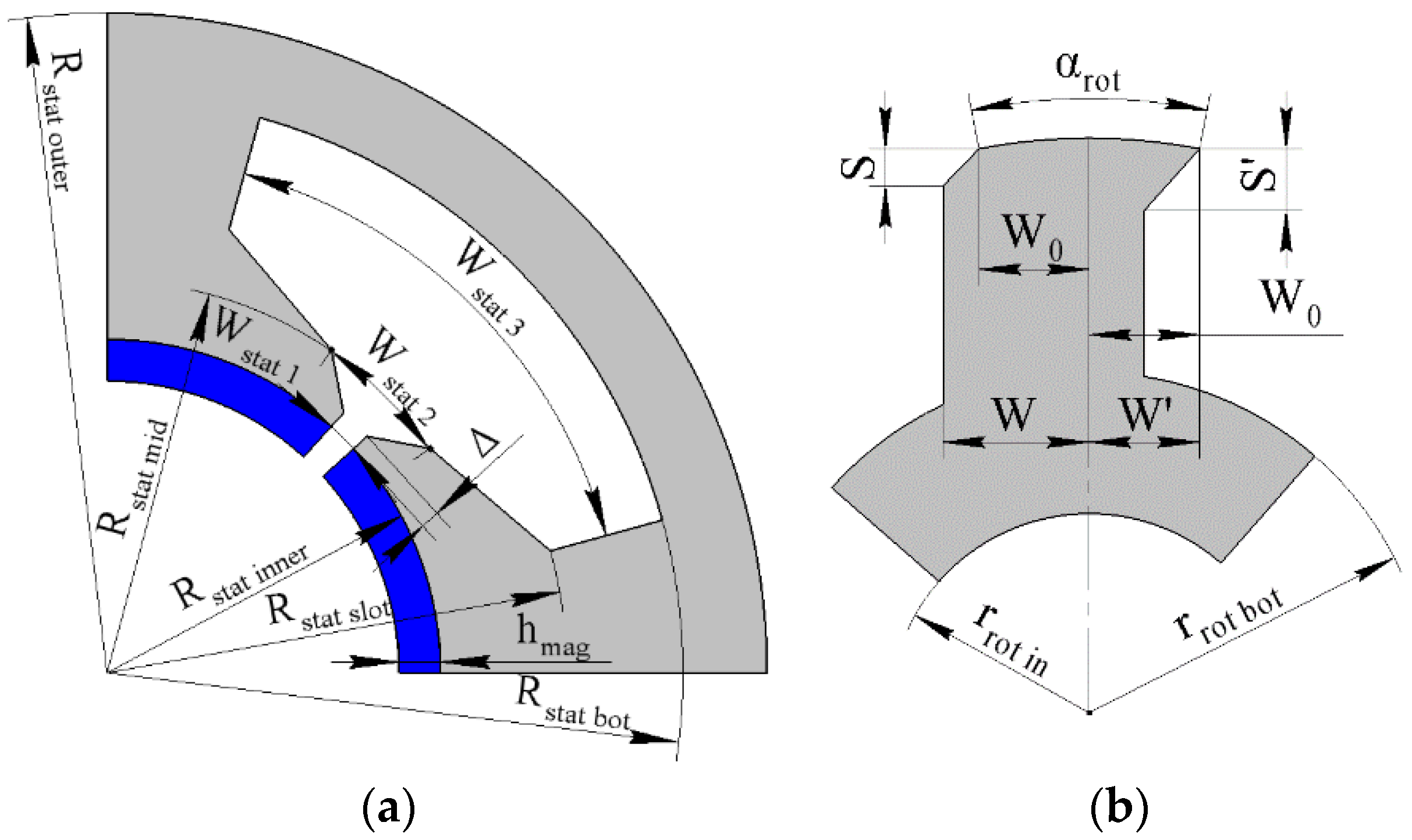
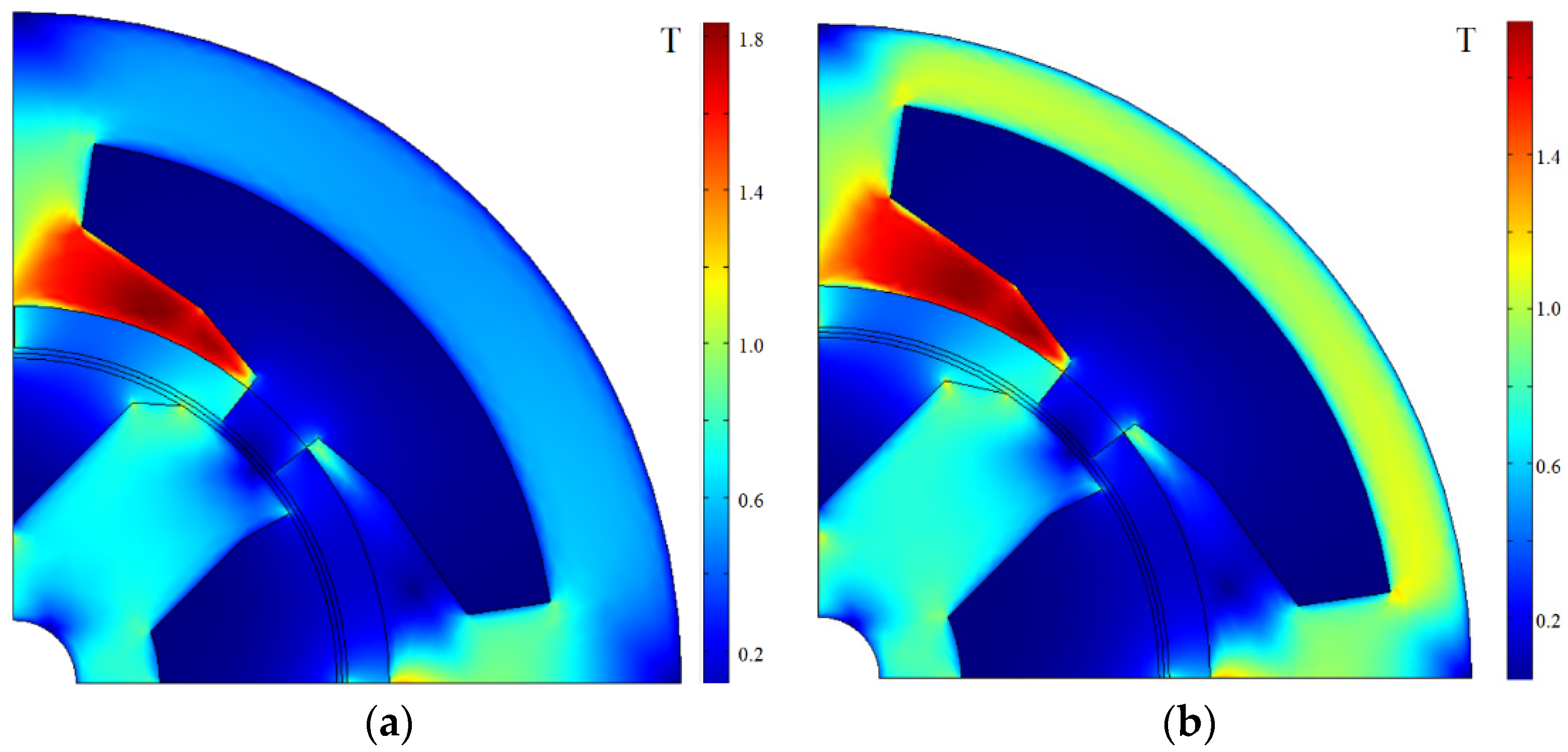
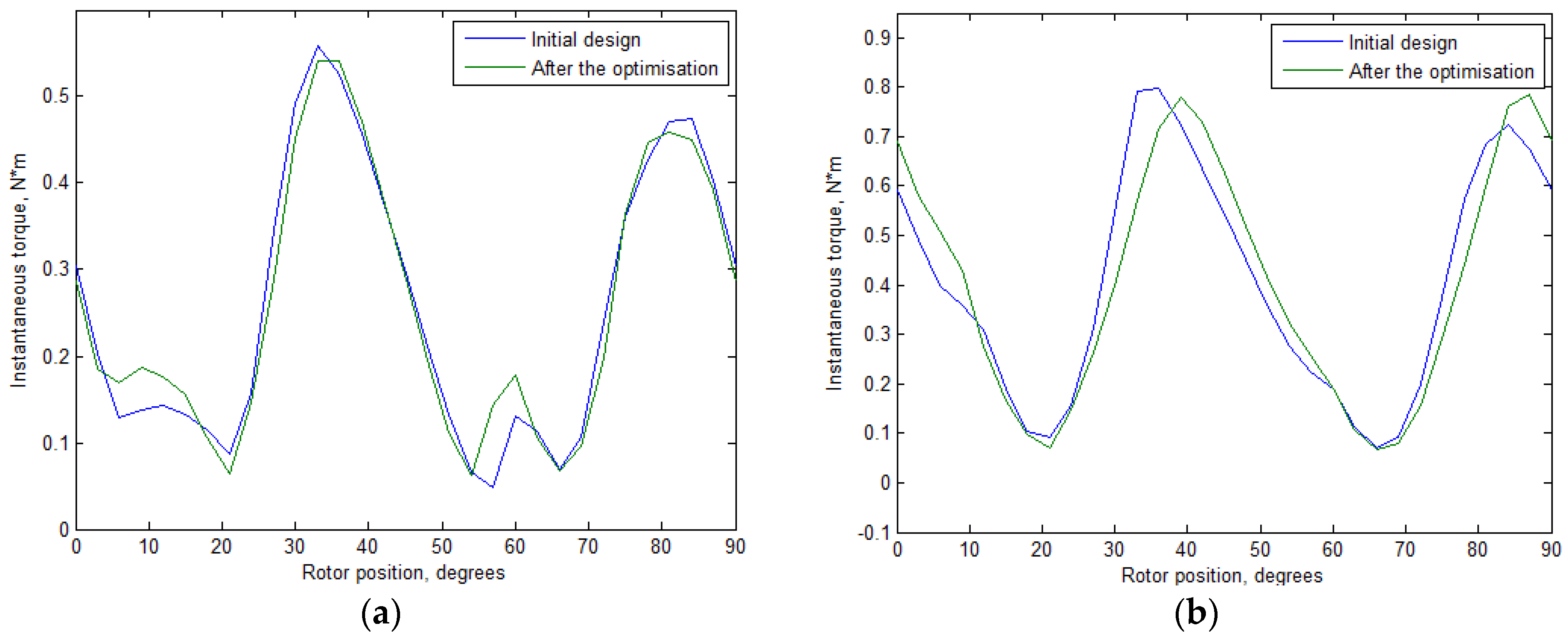
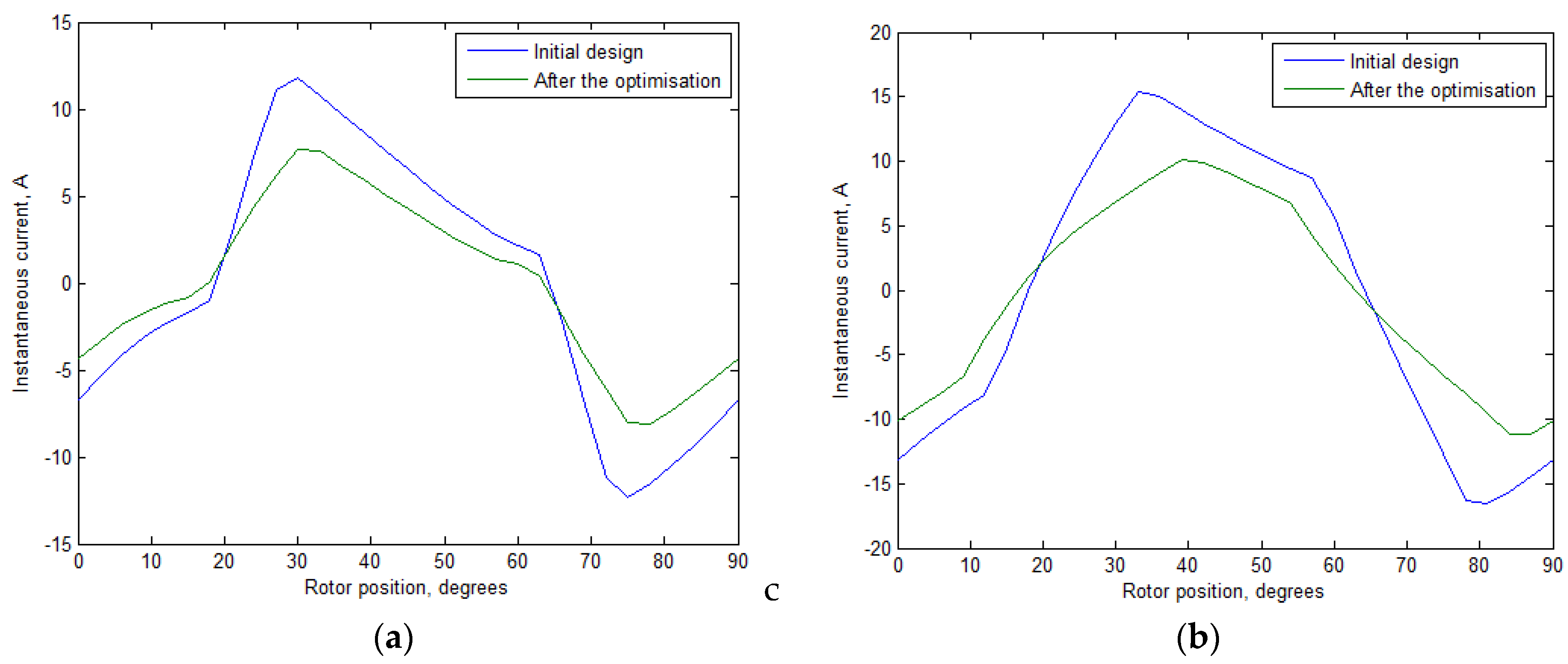
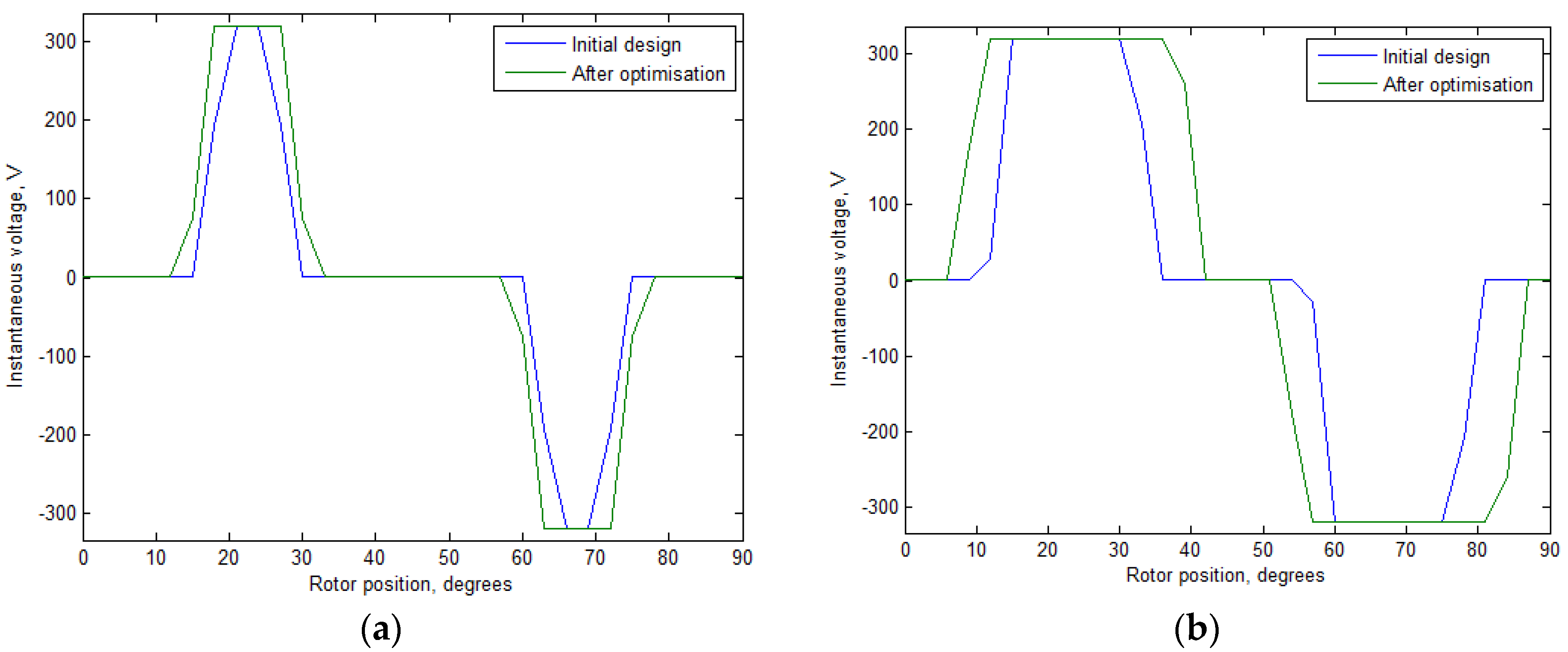
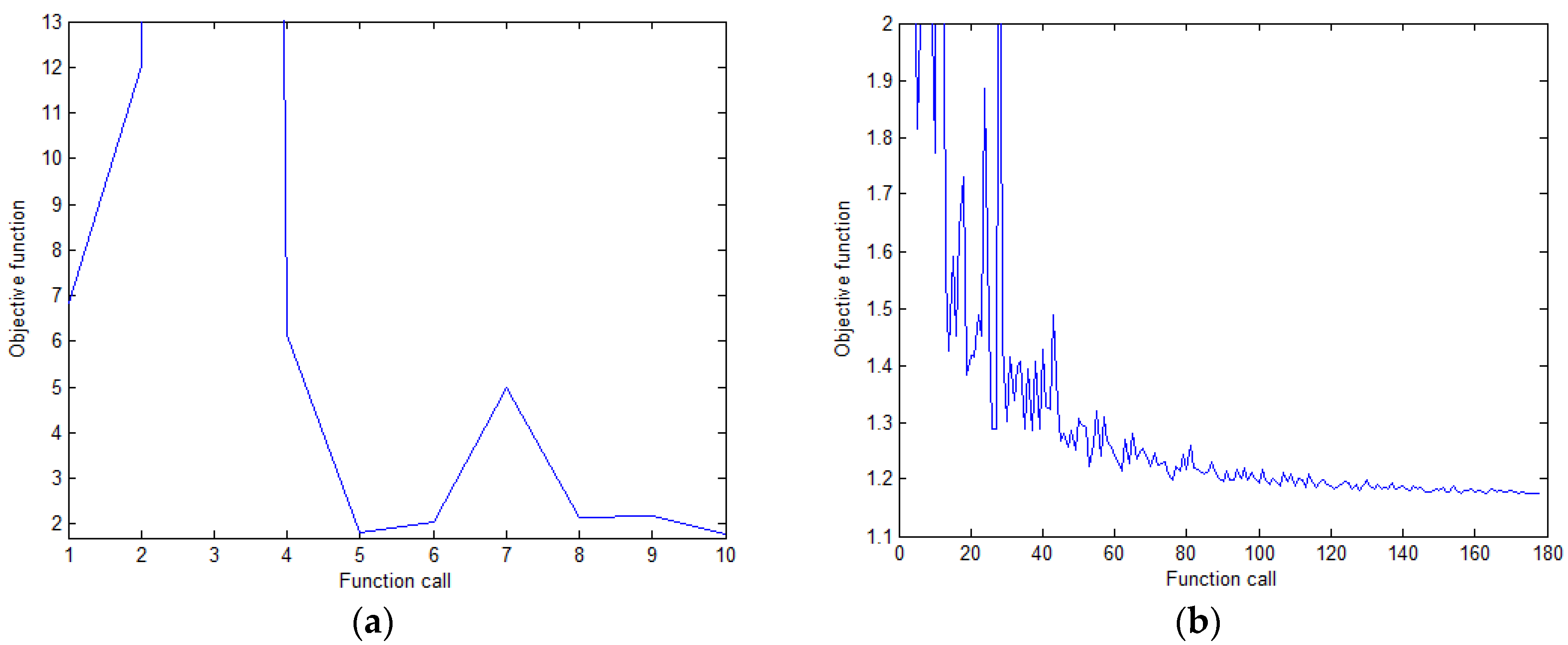
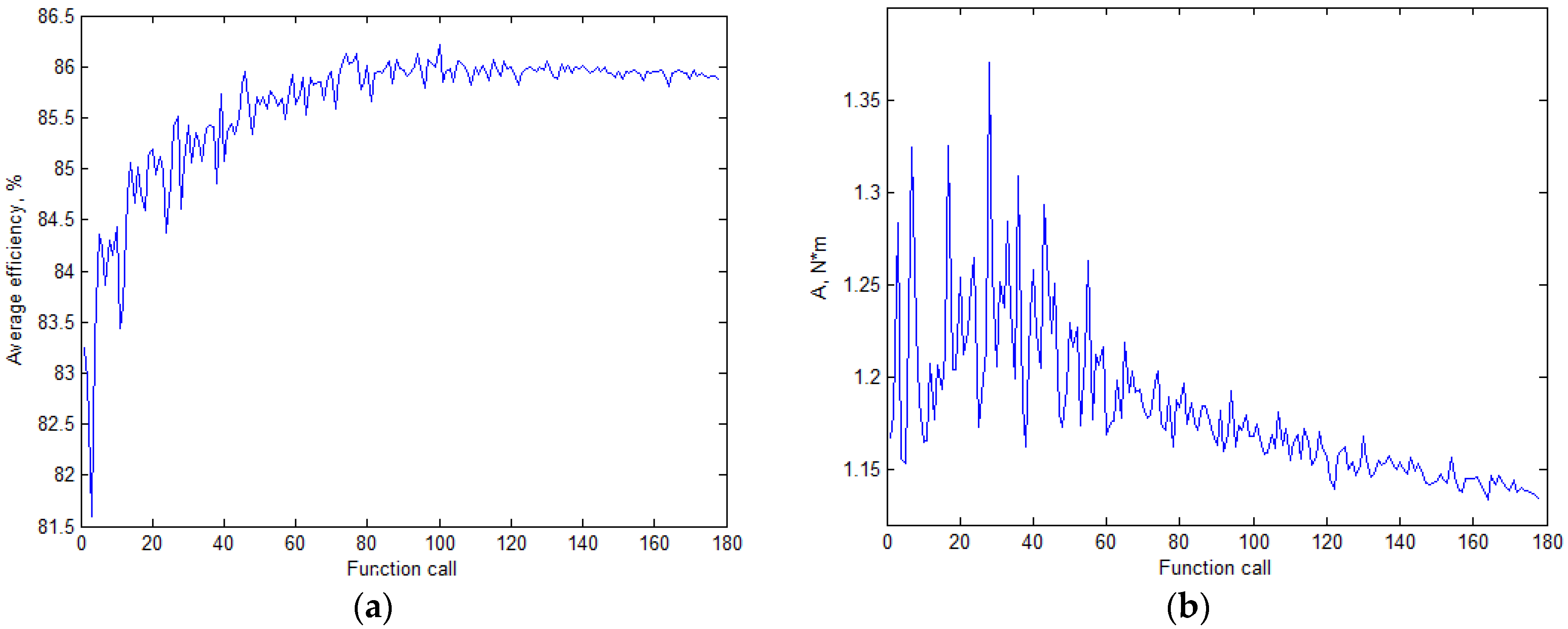
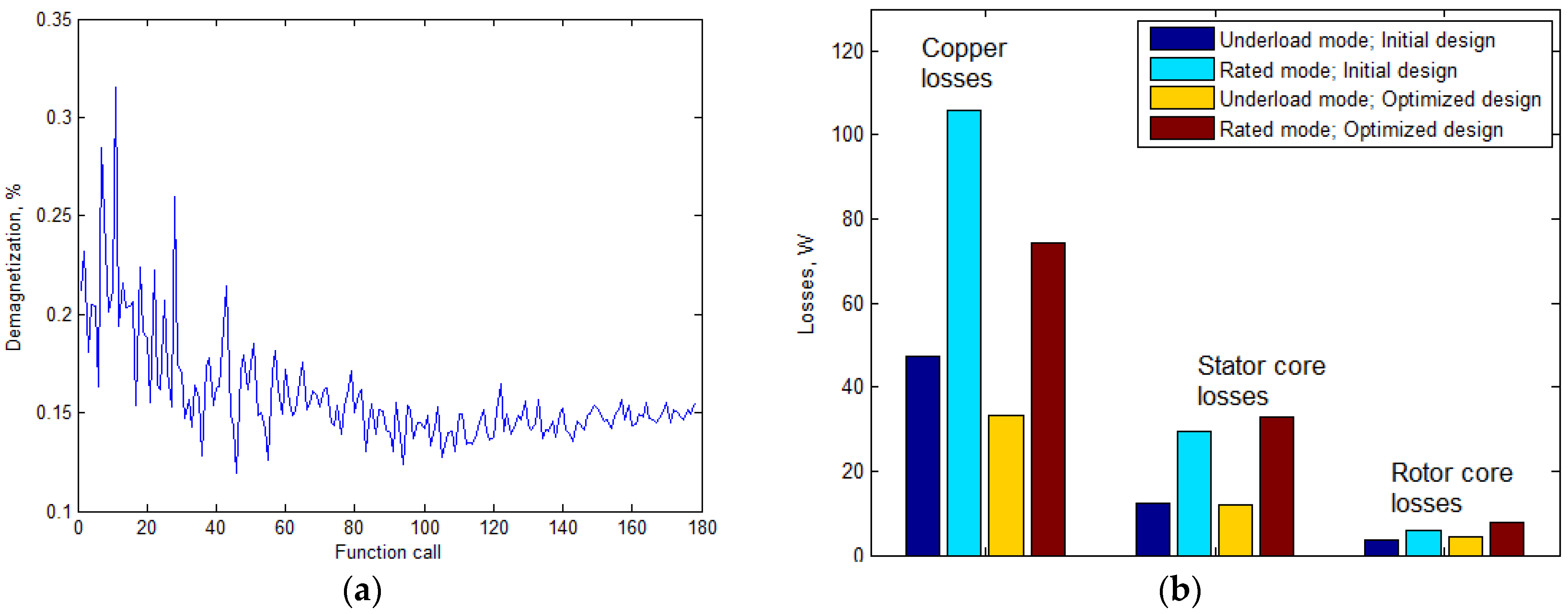
| Mode Number | Torque, N∙m | Rotational Speed, rpm | Rotational Speed, % | Mechanical Power, W |
|---|---|---|---|---|
| 1 | 0.256 | 14,400 | 80 | 386 |
| 2 | 0.4 | 18,000 | 100 | 754 |
| Parameter | Before | After |
|---|---|---|
| Number of turns per phase | 80–10 | 111 |
| Rstat,inner, mm | 18 + 1 | 19.2 |
| Rstat,slot, mm | 22 + 1 | 23.8 |
| Rstat,bottom, mm | 26 + 1 | 28.3 |
| Wstator1, degrees | 12.6 + 1.8 | 12.5 |
| αrot, degrees | 27–4.5 | 22.9 |
| w/w0 | 1.5–0.2 | 1.78 |
| W′/w0 | 0.8 + 0.2 | 0.72 |
| Voltage shift, electrical radians | 0.015 + 0.01 | 0.033 |
| Parameter | Value |
|---|---|
| Supply voltage, V | 320 |
| Stator stack length L, mm | 30 |
| Stator outer radius, Rstat_outer, mm | 32 |
| Stator slot width Wstat3, degrees | 72.9 |
| Stator slot width Wstat2, degrees | 36.5 |
| Δ, mm | 0.007 |
| Magnet thickness, mm | 2 |
| Air gap, mm | 0.5 |
| Magnet’s remanence, T | 0.65 |
| s, mm | 2 |
| S′, mm | 3 |
| Rrot bot, mm | 7 |
| Rinr, mm | 3 |
| Parameter | Before Optimization | After Optimization | ||
|---|---|---|---|---|
| Rotational speed, rpm | 14,400 | 18,000 | 14,400 | 18,000 |
| Electric frequency, kHz | 0.96 | 1.2 | 0.96 | 1.2 |
| Current, A (RMS) | 7.3 | 11 | 4.8 | 7.2 |
| Efficiency, % | 83.9 | 82.6 | 86.6 | 85.2 |
| Total losses, W | 72.2 | 156 | 58.2 | 128.5 |
| Mechanical power, W | 386 | 754 | 386 | 754 |
| Electric power, W | 449 | 895 | 435 | 868 |
| Duty cycle | 0.213 | 0.449 | 0.3 | 0.69 |
| Minimal instantaneous torque, N∙m | 0.048 | 0.07 | 0.063 | 0.068 |
| AMinDT, N∙m | 0.21 | 0.33 | 0.193 | 0.33 |
| PPTR, N∙m | 0.510 | 0.729 | 0.479 | 0.718 |
| A, N∙m | 1.16 | 1.12 | ||
| PPTR, % of the average value | 199 | 182 | 187 | 180 |
| Magnets deterioration, % | 0.056 | 0.21 | 0.059 | 0.15 |
| Stator core mass, g | 340 | 260 | ||
| Rotor core mass, g | 96 | 105 | ||
| Magnets volume, cm3 | 5.5 | 5.9 | ||
| Copper mass, g | 239 | 295 | ||
Publisher’s Note: MDPI stays neutral with regard to jurisdictional claims in published maps and institutional affiliations. |
© 2021 by the authors. Licensee MDPI, Basel, Switzerland. This article is an open access article distributed under the terms and conditions of the Creative Commons Attribution (CC BY) license (http://creativecommons.org/licenses/by/4.0/).
Share and Cite
Prakht, V.; Dmitrievskii, V.; Kazakbaev, V. Optimal Design of a High-Speed Flux Reversal Motor with Bonded Rare-Earth Permanent Magnets. Mathematics 2021, 9, 256. https://doi.org/10.3390/math9030256
Prakht V, Dmitrievskii V, Kazakbaev V. Optimal Design of a High-Speed Flux Reversal Motor with Bonded Rare-Earth Permanent Magnets. Mathematics. 2021; 9(3):256. https://doi.org/10.3390/math9030256
Chicago/Turabian StylePrakht, Vladimir, Vladimir Dmitrievskii, and Vadim Kazakbaev. 2021. "Optimal Design of a High-Speed Flux Reversal Motor with Bonded Rare-Earth Permanent Magnets" Mathematics 9, no. 3: 256. https://doi.org/10.3390/math9030256
APA StylePrakht, V., Dmitrievskii, V., & Kazakbaev, V. (2021). Optimal Design of a High-Speed Flux Reversal Motor with Bonded Rare-Earth Permanent Magnets. Mathematics, 9(3), 256. https://doi.org/10.3390/math9030256








